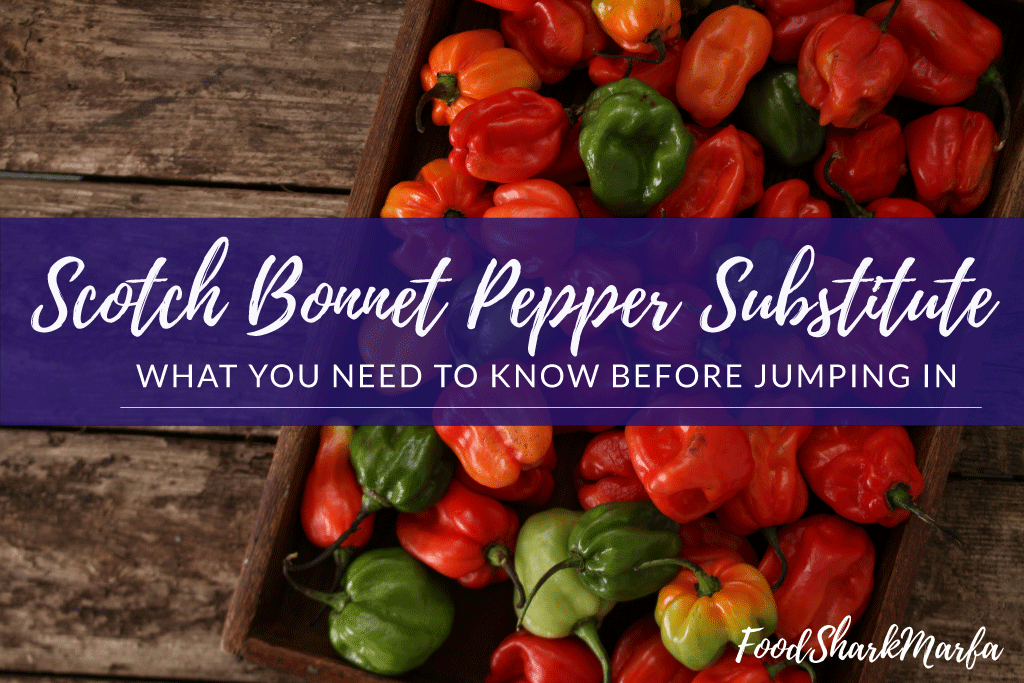If you’ve ever taken a vacation to the Caribbean, you’ve likely experienced delicious dishes containing Scotch bonnet peppers. That’s because this pepper is the most used in this area of the world for extra spicy dishes. These peppers are typically grown in Jamaica and are sold in both fresh and dried forms.
The heat rating of this pepper, also known as the Scoville rating, runs between 100,000 and 350,000, giving it a spicy kick comparable to other hot peppers such as the habanero. While the Scotch Bonnet does have a distinctive taste of its own, there are several substitutes you can use to recreate its flavor and heat if you can’t get your hands on the real thing.What is a scotch bonnet pepper?
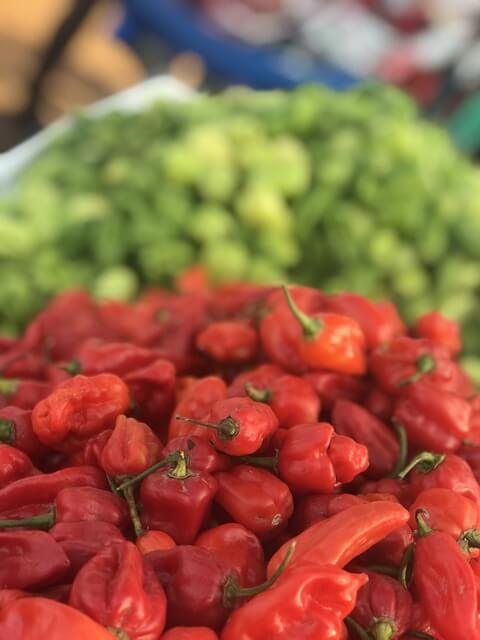
The name of the Scotch bonnet pepper comes from their distinctive shape. These peppers are flattened and considered to look like a bonnet that a Scotsman would wear. It also has several other names depending on where you are in the Caribbean. For example, you may also hear them referred to as “Jamaican hots” or “Bahama mamas”. Some of the peppers are less flat, but still have that spicy flavor Caribbean cooking is so famous for.
Keep in mind that this is one of the hottest peppers you can get your hands on, with about the same spice level as a habanero. It is much spicier than a pepper like a jalapeno, especially when bought in areas with a large community of Caribbean individuals. They are often more expensive than other peppers and can come sliced, chopped, or as whole peppers.How healthy (or unhealthy) is it?
For those who can handle all the heat of Scotch bonnet peppers, there are a few health benefits to consuming them. They contain a number of vitamins, including vitamins A, B, and C. They are also high in nutrients such as magnesium, iron, riboflavin, niacin. This kind of pepper also offers high numbers of flavonoids, dietary fiber, carotenoids, and phytochemicals.
The capsaicin in the pepper is what makes it spicy, and it can be used to improve osteoarthritis, diabetic neuropathy, headaches, and rheumatoid pain. It is also often used to help relieve sinusitis and congestion.
Nutritional Breakdown
Scotch bonnet pepper | Amount (per 10 peppers) | % Recommended daily intake |
Calories | 201 kcal | 10% |
Total fat | 0 g | 0% |
Saturated fat | 0 g | 0% |
Carbohydrates | 30 g | 11% |
Cholesterol | 0 mg | 0% |
Salt | 100 mg | 5% |
Protein | 10 g | 20% |
Sugars | 20 g | 53% |
Vitamin B-12 | 0 ug | 0% |
Scoville rating | 100,000 – 350,000 | - |
What recipes use scotch bonnet peppers?
There are many recipes for Caribbean hot pepper sauce and each contains unique ingredients depending on the tastes of the cook. However, the one ingredient almost every recipe will have in common is the Scotch bonnet pepper. Scotch bonnet peppers are also a staple of jerk dishes like chicken, where you spice the meat liberally and then cook them on some type of grill. Some of the other dishes that make use of Scotch bonnet peppers include certain kinds of jam, barbequed meat, Creole sauce, and stuffed chile peppers.
Why do we need scotch bonnet pepper substitutes?
While Scotch bonnet peppers are a fantastic choice for heat and a fruity flavor, they are also hard to find in areas without a large Caribbean population. Most supermarkets do not carry them, so they can be challenging to find. This can pose a problem if you want to use a recipe that makes use of this pepper. However, there are several other options that you can use as a substitute for Scotch bonnet peppers that will ensure your dish is just as delicious as if you’d used the real thing.
Note:
🌱 = vegan
1. Habanero pepper🌱
Best for: hot sauce, salsa, chili paste, wings, and jelly.
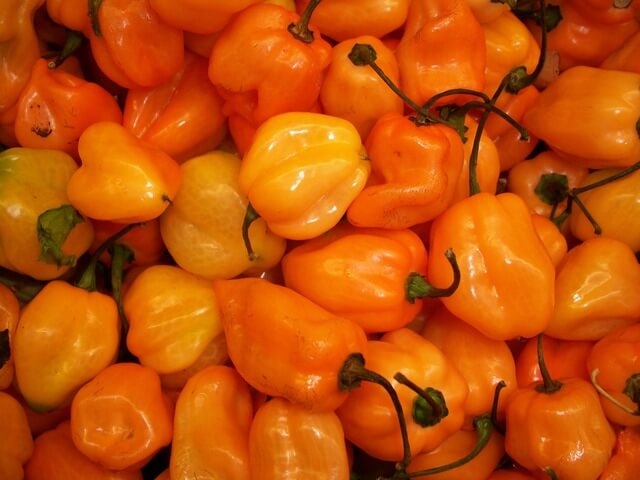
Overview
The habanero pepper is a scorching, small chile pepper that is grown in various parts of Latin America as well as the United States. This pepper has a thin skin and is shorter and squatter than many other peppers. It comes in a range of colors from red to orange. As a very hot pepper, it is not recommended to eat it whole. However, it can be used in recipes like salsa, salad dressing, and sauces.
Advantages
Most of the time, you won't be eating enough of this Scotch bonnet pepper substitute to gain a large number of nutrients from it. However, you can have peace of mind knowing that it is fat-free, low-calorie, and contains very little sodium. The pepper also contains a decent amount of potassium and vitamin C. As an alternative to the Scotch bonnet, it has about the same heat level, so it will work in most of the same recipes without the need for any alterations.
Disadvantages
As one of the hottest peppers you can find on the market, the habanero pepper can cause problems for people who have digestive issues. This includes issues like irritable bowel syndrome, heartburn, and acid reflux. Also, while it has some nutrients, they are in small amounts for most recipes. The slightly fruity flavor of this pepper can be an advantage or a downfall depending on the kind of dishes you plan to make with it.
Nutritional breakdown
Habanero pepper | Amount (per 100 g) | % Recommended daily intake |
Calories | 38 kcal | 2% |
Total fat | 0 g | 0% |
Saturated fat | 0 g | 0% |
Carbohydrates | 8 g | 3% |
Cholesterol | 0 mg | 0% |
Salt | 0 mg | 0% |
Protein | 0 g | 0% |
Sugars | 0 g | 0% |
Vitamin C | 92 mg | 118% |
Scoville rating | 100,000 – 350,000 | - |
2. Jalapeno pepper🌱
Best for: jalapeno poppers, mac and cheese, burgers, sauces, and vegetables.
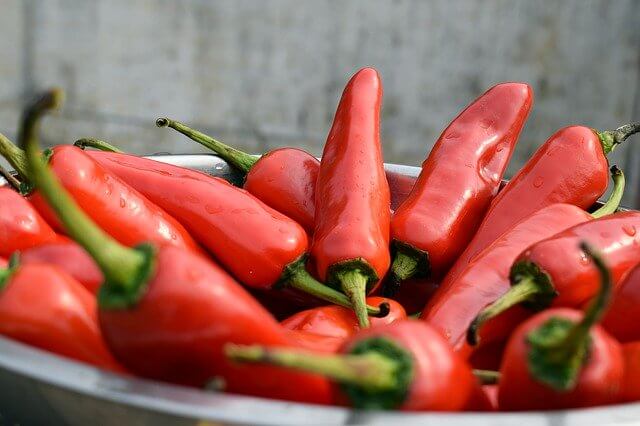
Overview
The jalapeno is less hot than the other peppers we have covered so far and is a member of the nightshade family. That means it is in the same category as vegetables like potatoes, tomatoes, and eggplant. As with other hot peppers you can use as a Scotch bonnet pepper substitute, the spice level will vary based on the pH of the soil as well as how much sunlight it has grown in. These are often used in Mexican dishes and are inexpensive and available at most supermarkets.
Advantages
Jalapeno peppers contain only a few calories, but a single pepper can offer nearly a third of your daily value of vitamin C. In addition to that, they include vitamin B6, vitamin A, vitamin K, and folate. Minerals found in the jalapeno include copper, magnesium, manganese, iron, and potassium. Capsaicin, which is what creates the heat in the pepper, can also help lower blood pressure, reduce hunger, and aid digestion.
Disadvantages
The main downfall of choosing jalapenos instead of Scotch bonnet peppers is that they are much milder. Also, jalapenos don't have the same fruitiness that some peppers add to a dish. For recipes that need a large amount of heat, the results of jalapenos may not live up to expectations. However, they are easy to find and make a good option if you prefer your dishes with a little less spice.
Nutritional breakdown
Jalapeno pepper | Amount (per 100 g) | % Recommended daily intake |
Calories | 29 kcal | 1% |
Total fat | 0.4 g | 0.7% |
Saturated fat | 0 g | 0% |
Carbohydrates | 7 g | 3% |
Cholesterol | 0 mg | 0% |
Salt | 3 mg | 0.2% |
Protein | 1 g | 2% |
Calcium | 12 mg | 16% |
Vitamin B-12 | 0 ug | 0% |
Scoville rating | 2,500 – 8,000 | - |
3. Serrano pepper 🌱
Best for: relishes, garnishes, salsas, hot sauces, and meatballs.
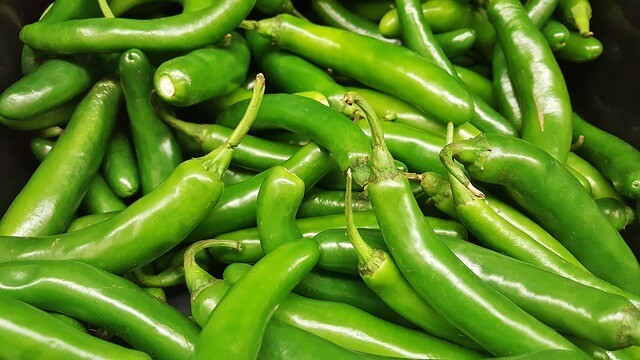
Overview
The serrano pepper is named after the mountains in Mexico, where they were first produced. While they are a pepper, they’re also considered a fruit and are commonly included in authentic Mexican dishes. You’ll also find dishes from Southeast Asia that use these peppers to add a tasty bite of flavor to your favorite recipes. With a good amount of heat and sharpness, this Scotch bonnet pepper substitute can be used raw or cooked in many dips and sauces. They can also be cooked or pickled.
Advantages
As far as nutrition goes, the serrano pepper is low in calories, and most of the calories it does contain are made of fiber. This pepper is low in cholesterol and fat while being high in vitamin A and vitamin C. The capsaicin in the pepper is also believed to be good for heart health alongside the other benefits we’ve previously mentioned. Beyond that, serrano peppers are one of the easier to find varieties and can add a decent kick of heat and spice to dishes of all kinds.
Disadvantages
One of the things that separates serrano peppers from Scotch bonnet peppers is that serrano peppers have far less heat. Those who are looking for a serious kick may be disappointed by the low level of warmth with this pepper. While they are easy to find in most supermarkets, there are other spicier options you can find without much trouble that will give you more heat and will work better in recipes that rely on that.
Nutritional breakdown
Serrano pepper | Amount (per 100 g) | % Recommended daily intake |
Calories | 32 kcal | 2% |
Total fat | 0.4 g | 0.7% |
Saturated fat | 0 g | 0% |
Carbohydrates | 7 g | 3% |
Cholesterol | 0 mg | 0% |
Salt | 10 mg | 0.5% |
Protein | 2 g | 4% |
Calcium | 11 mg | 1% |
Vitamin C | 45 mg | 60% |
Scoville rating | 10,000 – 23,000 | - |
4. Rocotillo pepper 🌱
Best for: soups, stews, salsa, garnish, or lamb and beef.
Overview
A rocotillo pepper has a similar shape to a Scotch bonnet pepper but is much milder. This is an extremely mild pepper that is just a bit hotter than the poblano. However, it also has a bit more sweetness to it than some peppers will. There is often some confusion over this pepper since there are two varieties: one from Peru and the other from an unknown origin source. However, both look similar and have the same amount of heat.
Advantages
If you’re someone who prefers a Scotch bonnet pepper substitute that has far less heat, the rocotillo is going to be one of the best options for you. While a Scotch bonnet pepper has a Scoville rating of 100,000 or more, the rocotillo pepper is in the 1,500 to 2,500 range of heat. Another advantage of choosing this pepper is that it contains the same fruity taste found in Scotch bonnets, so you can easily use it in Caribbean dishes.
Disadvantages
The first thing that can be frustrating when looking for rocotillo peppers is that they are very hard to find on the market. In fact, in most cases, it is going to be even harder to procure rocotillo peppers than it is to find Scotch bonnet peppers. This is also not a pepper for those craving a lot of heat, as isn't as spicy as other options.
Nutritional breakdown
Rocotillo pepper | Amount (per 100 g) | % Recommended daily intake |
Calories | 40 kcal | 2% |
Total fat | 0.4 g | 0.7% |
Saturated fat | 0 g | 0% |
Carbohydrates | 9 g | 3% |
Cholesterol | 0 mg | 0% |
Salt | 9 mg | 0.5% |
Protein | 5 g | 10% |
Calcium | 14 mg | 1% |
Vitamin B-12 | 0 ug | 0% |
Scoville rating | 1,500 – 2,500 | - |
5. Thai red chile 🌱
Best for: curry, sauces, soups, seafood, and poultry.
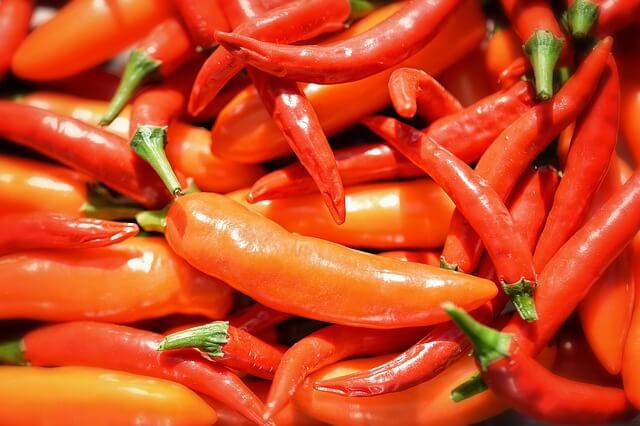
Overview
The Thai red chile is another pepper that is part of the nightshade family and can refer to several peppers of similar shapes, sizes, and levels of spice. These peppers are called different things in various regions, which can sometimes lead to confusion among consumers. Sometimes you will see these peppers called Bird's Eye peppers because birds commonly enjoy the peppers. While these peppers are not quite as hot as Scotch bonnet peppers, they have a good level of heat, ranging from 50,000 and up on the Scoville scale.
Advantages
Thai red chile peppers can be used raw as well as in cooked dishes made through boiling, sautéing, and stir-frying. They also have a lot of heat, which makes them an excellent substitute for Scotch bonnet peppers. Where health is concerned, these peppers offer vitamin A, vitamin C, vitamin B6 as well as vitamin K. They also include fiber, potassium, and copper to help meet your recommended daily intake of vitamins and minerals.
Disadvantages
While these peppers do have a fruity note to them, they also have an earthy flavor that you won’t find in the Scotch bonnet, which may bring undesirable flavors to your dish. It can also be rather confusing to buy these peppers, as there are several varieties with different flavors and levels of heat.
Nutritional breakdown
Thai red chile | Amount (per 100 g) | % Recommended daily intake |
Calories | 40 kcal | 2% |
Total fat | 0.6 g | 1% |
Saturated fat | 0 g | 0% |
Carbohydrates | 3 g | 1% |
Cholesterol | 0 mg | 0% |
Salt | 0 g | 0% |
Protein | 2 g | 4% |
Calcium | 0 mg | 0% |
Vitamin B-12 | 0 ug | 0% |
Scoville rating | 50,000 - 100,000 | - |
(Based on nutritional information from USDA.)
The Bottom Line
The Scotch bonnet pepper is prevalent in many dishes, especially those that are expected to put out a ton of heat. The only issue is that unless you live somewhere with a large Caribbean community, this particular pepper can be extremely hard to find. That's why having a few alternatives can be a great idea, especially if you frequently cook with hot peppers. Our selection of substitutes ranges from the extremely hot to the milder so you can select the option that best fits your individual palate.
Top vegan picks
All of the peppers we list in this article are vegan, containing no animal products or by-products. Since that is the case, our top vegan pick is the habanero pepper since it has the same sweetness and high level of heat as the Scotch bonnet pepper. If you’re someone who prefers less heat than a Scotch bonnet provides, you may want to choose a jalapeno pepper instead, which will bring the flavor without the extra heat.
Top healthy picks
Most of the Scotch bonnet pepper substitutes on this list are healthy options. Many of them offer a low-fat, low-calorie choice with an assortment of vitamins, minerals, and other nutrients. One of the healthiest substitutes is the serrano pepper, which has plenty of both vitamin A and C. Jalapeno peppers are another choice for health and wellness, with several vitamins and minerals that the other peppers do not offer in such high amounts.
Top convenient picks
When thinking about the convenience factor, you have to think about your location. If you are in an area with a large number of people from the Caribbean, Scotch bonnet peppers are easy to find. However, for the vast majority of people, the most convenient peppers are going to be jalapeno peppers and habanero peppers. It can be a more considerable challenge to get rocotillo peppers or even Thai red chile peppers.
Top convincing picks
So, you have a recipe that calls for Scotch bonnet peppers but no way to access them. If you want a convincing Scotch bonnet pepper substitute, some alternatives are going to be better than others. The very best choice for the same flavor and heat of a Scotch bonnet is a habanero pepper. It brings that same level of spice as the Scotch bonnet that many other peppers lack. It also has the fruity flavor in the background that works so well for Caribbean recipes.
Sources:
https://www.gourmetsleuth.com/ingredients/detail/scotch-bonnet-pepper
https://www.thespruceeats.com/scotch-bonnet-chili-2137836
https://www.thespruceeats.com/what-are-habanero-peppers-995710
https://www.chilipeppermadness.com/chili-pepper-types/sweet-mild-chili-peppers/rocotillo-chili-peppers/

